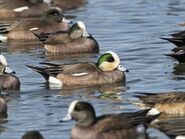American Wigeons are a common sight across much of North America, their whistles sending quiet ponds and lakes alive with dabbing ducks.
Appearance[]
American Wigeons are medium-sized, compact ducks with a short pale gray bill with a black tip and a round head. They tend to sit on the water with their heads pulled down, making them look like they have no neck.
Breeding males have a brownish gray head with a wide green stripe behind the eye and a gleaming white cap. The body is pale cinnamon with white patches on the sides of the rump that contrast with the black undertail feathers. In flight, the white patch on the upperwing and a green patch on the secondaries are visible. Females and nonbreeding males are warm brown with a brownish gray head and a dark smudge around the eye.
American Wigeons are 16.5-23.2 inches (42-59 centimeters) in length and are 19.1-46.9 ounces (540-1330 grams) in weight. They have a wingspan of 33.1 inches (84 centimeters).
Occurrence[]
At all times of year, American Wigeons can be found in slow-moving bodies of water that typically have plentiful vegetation.
Life History[]
Diet[]
American Wigeons feed primarily on both aquatic and terrestrial plants. During the breeding season, they eat more insects and aquatic invertebrates. Females in particular eat more insects because they need the extra protein for laying eggs.
Nesting[]
American Wigeons nest on the ground, the female American Wigeon the one who selects a nest site. The nest site is on dry ground, often far from water, in fields and grasslands with tall grasses or low shrubs.
When making the nest, females make a small depression on the ground and line it with plant matter, and down feathers. Females continue to add material to the nest during egg laying and incubation. The completed nest is about 8 inches across.
American Wigeons only have one brood per year with 3-13 eggs in each. The eggs are creamy white with a length of 2-2.2 inches (5.1-5.5 centimeters) and width of 1.5 inches (3.7-3.8 centimeters). The incubation period is 22-28 days. After the eggs hatch, the hatchlings are covered on down and are able to leave the nest soon after hatching.
Behavior[]
Compared to other dabbling ducks, American Wigeons spend more time swimming and cover more ground between foraging periods. When startled, they erupt in flight from the water's surface, flying erratically and rapidly.
Males aggressively compete for females on the wintering grounds, frequently chasing females and fighting off rival males with bill snaps and threatening postures. Courtship displays include tail wagging, thrusting the head, neck, and chest upward, shaking the body, lifting and arching the wings up over the back, head dipping, and wing shaking. Throughout courtship displays males also give a slow high-pitched whistle. Once paired, they stay together until the female is partway through incubation, after which the male usually leaves and prepares to molt.
Males leave the breeding grounds first, followed by females and immatures. On their wintering grounds they congregate in large groups often mixing with other ducks and American Coots.
Sounds[]
American Wigeons are more vocal than most of the dabbling ducks. Males give slow, high-pitched whistles year-round. Their 3-parted nasal whistle sounds a bit like someone softly blowing through a kazoo. Females don't whistle, but instead give a harsh, grating grunt or growl during courtship.
Status[]
American Wigeons are common, but their populations have suffered a small decline recently.
Gallery[]
Trivia[]
- The Eurasian Wigeon turns up as a rarity in flocks of American Wigeons occasionally, but the American Wigeon also turns up in Europe in flocks of Eurasian Wigeons.
- American Wigeons eat a higher proportion of plant matter than any other dabbling duck thanks to the shortness of their gooselike bill.
- After breeding, successful males and unsuccessful females head north to large lakes where they spend many flightless days growing new feathers before heading south. Successful females and juveniles don't move to molt but they stay in their breeding areas to grow new feathers.
- American Wigeons are also known as "baldpate" because the white stripe resembles a bald man's head.
- The oldest American Wigeon reported was at least 21 years and 4 months old.
- American Wigeons are also called Silbón Americano (in Spanish) and Canard d'Amérique (in French).








